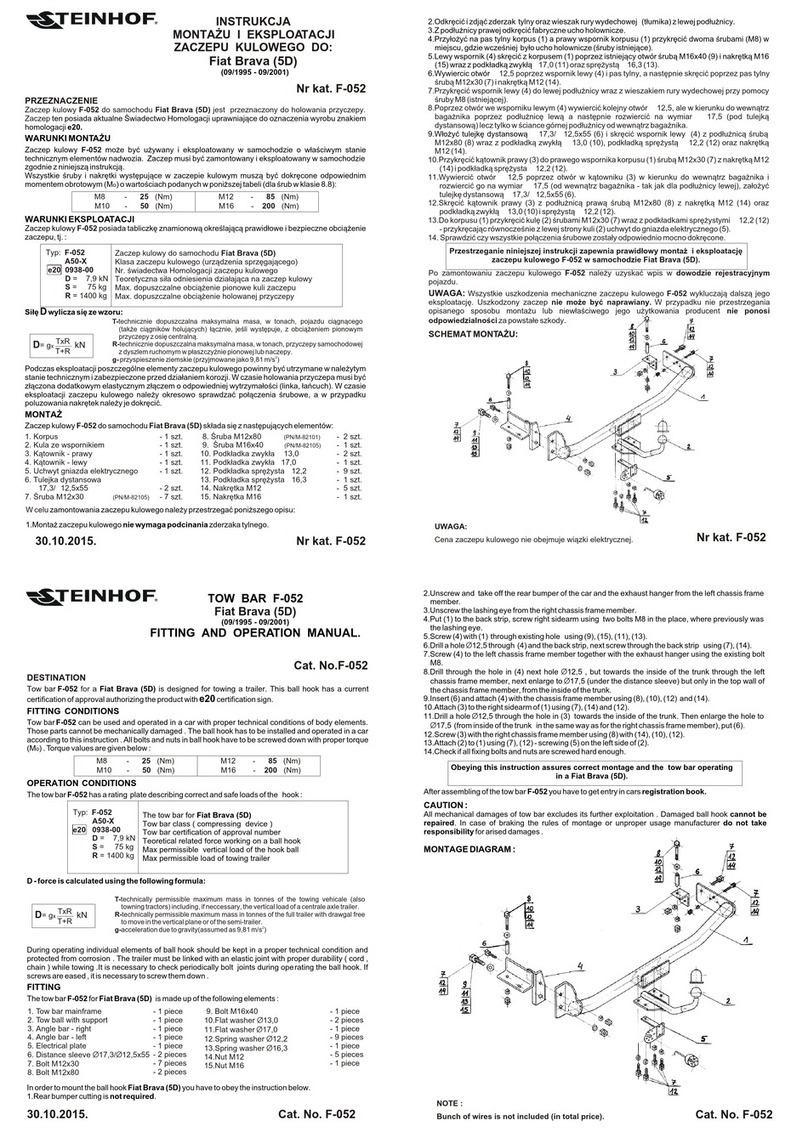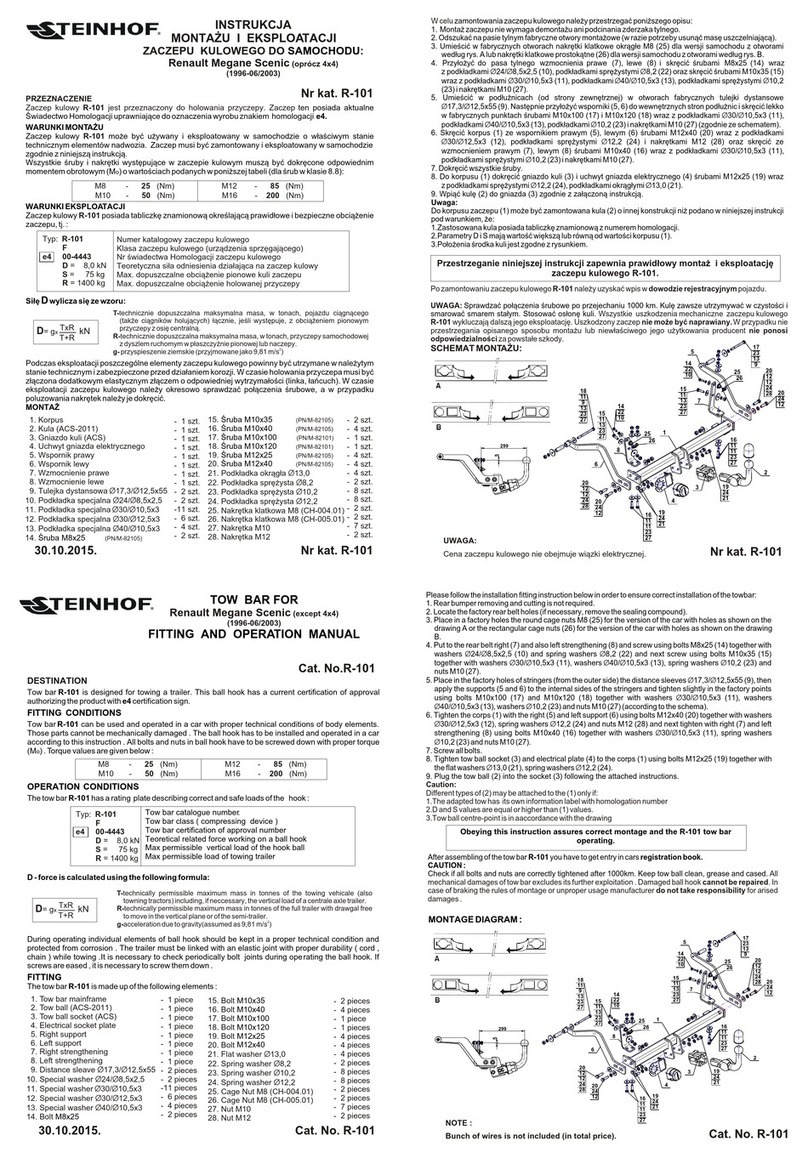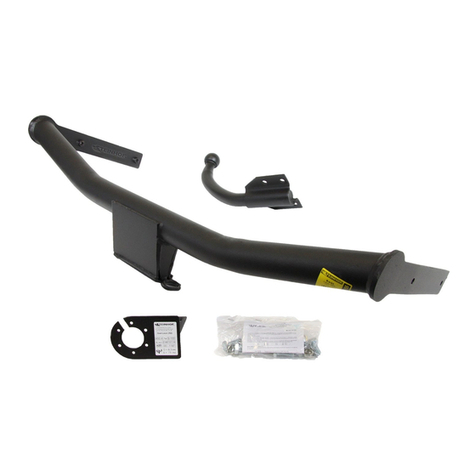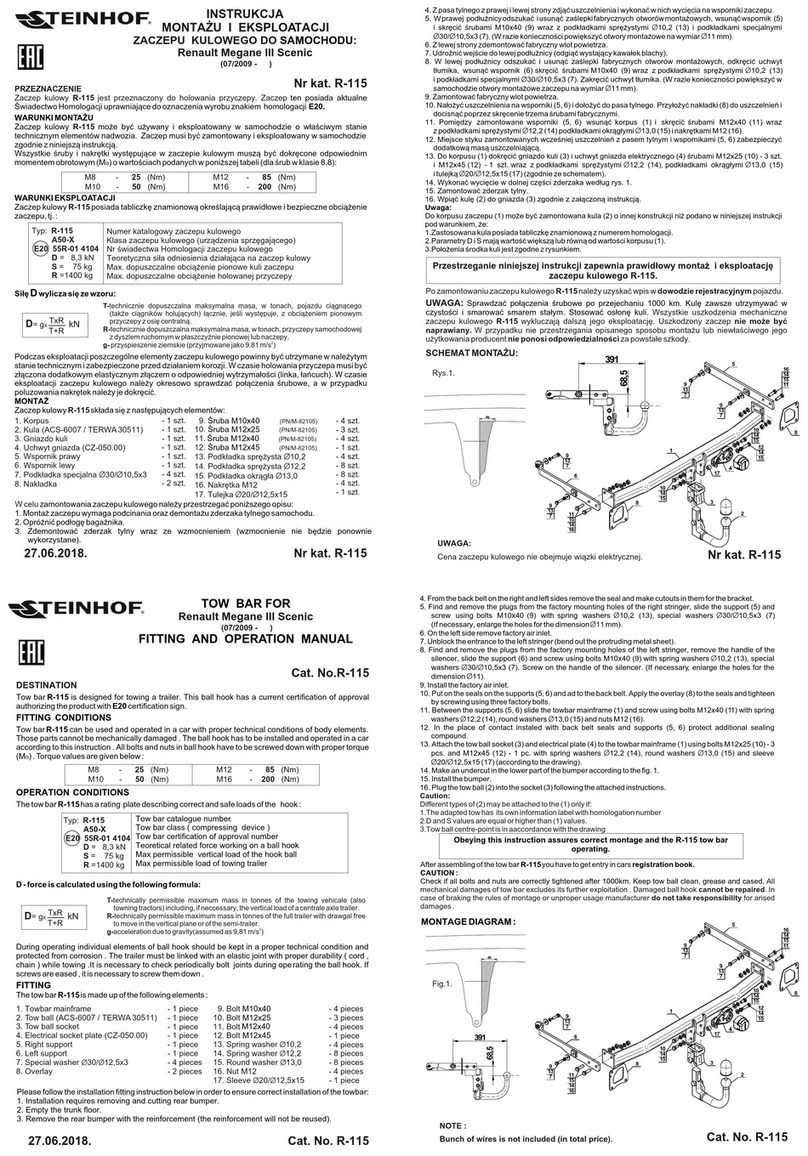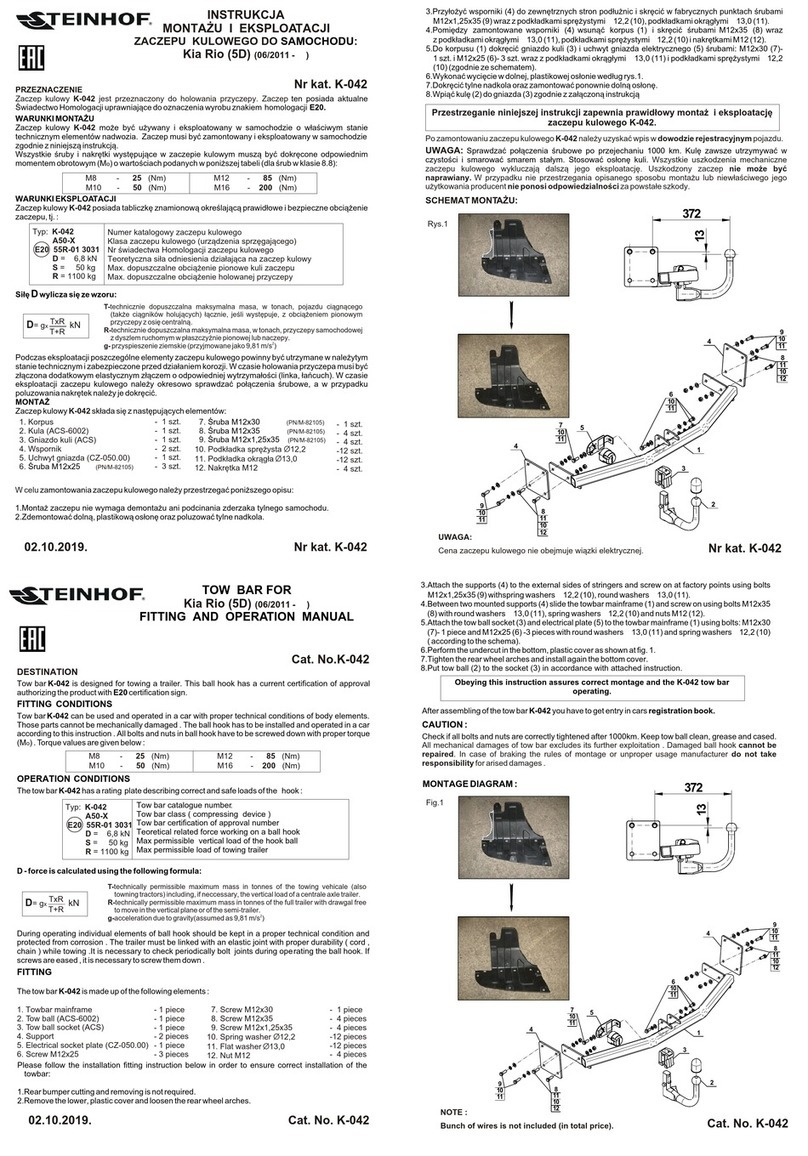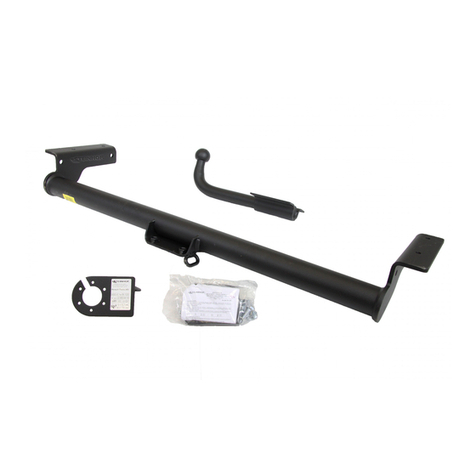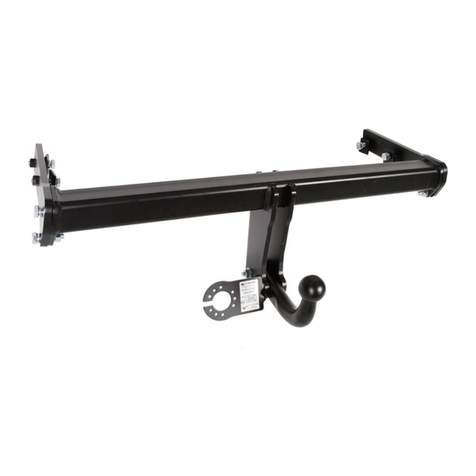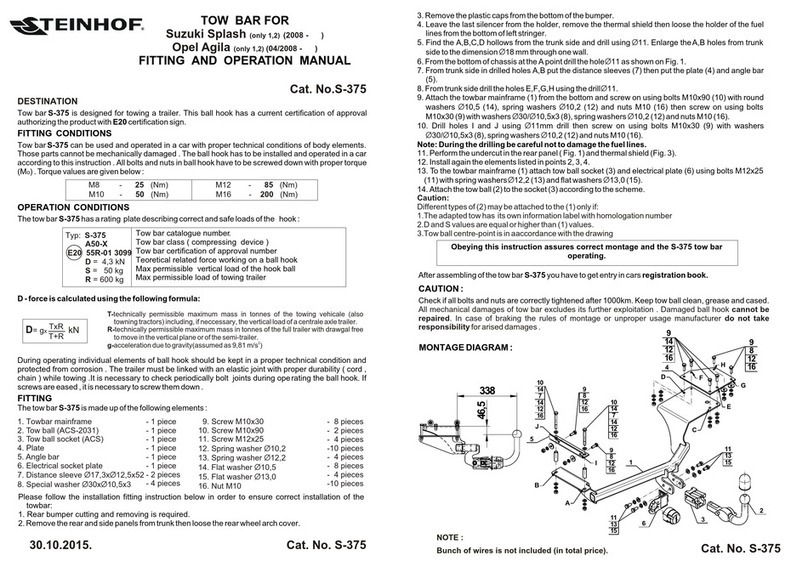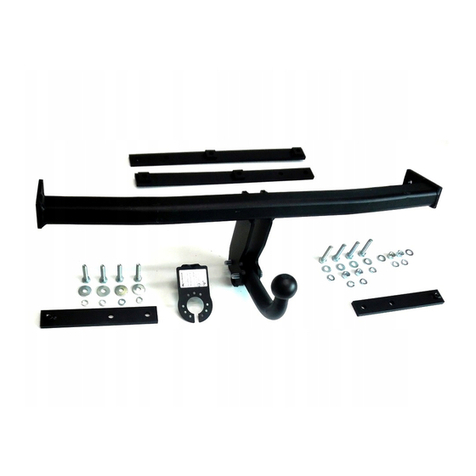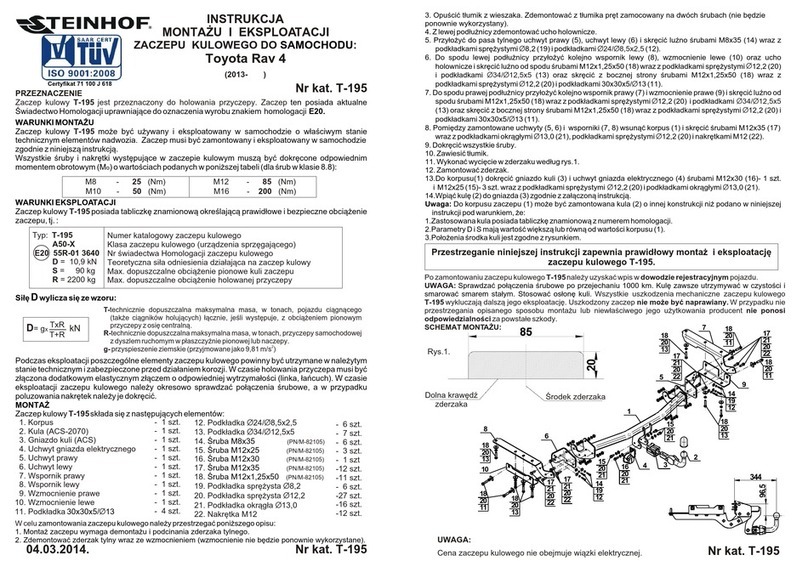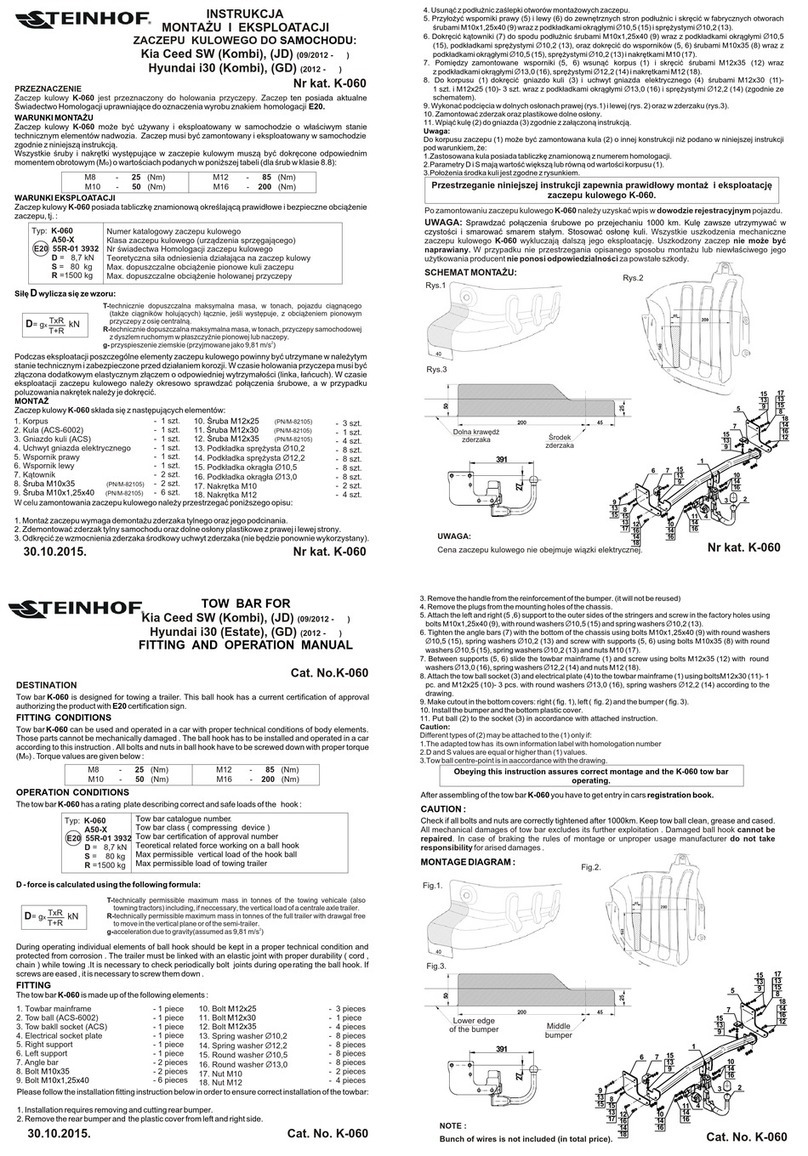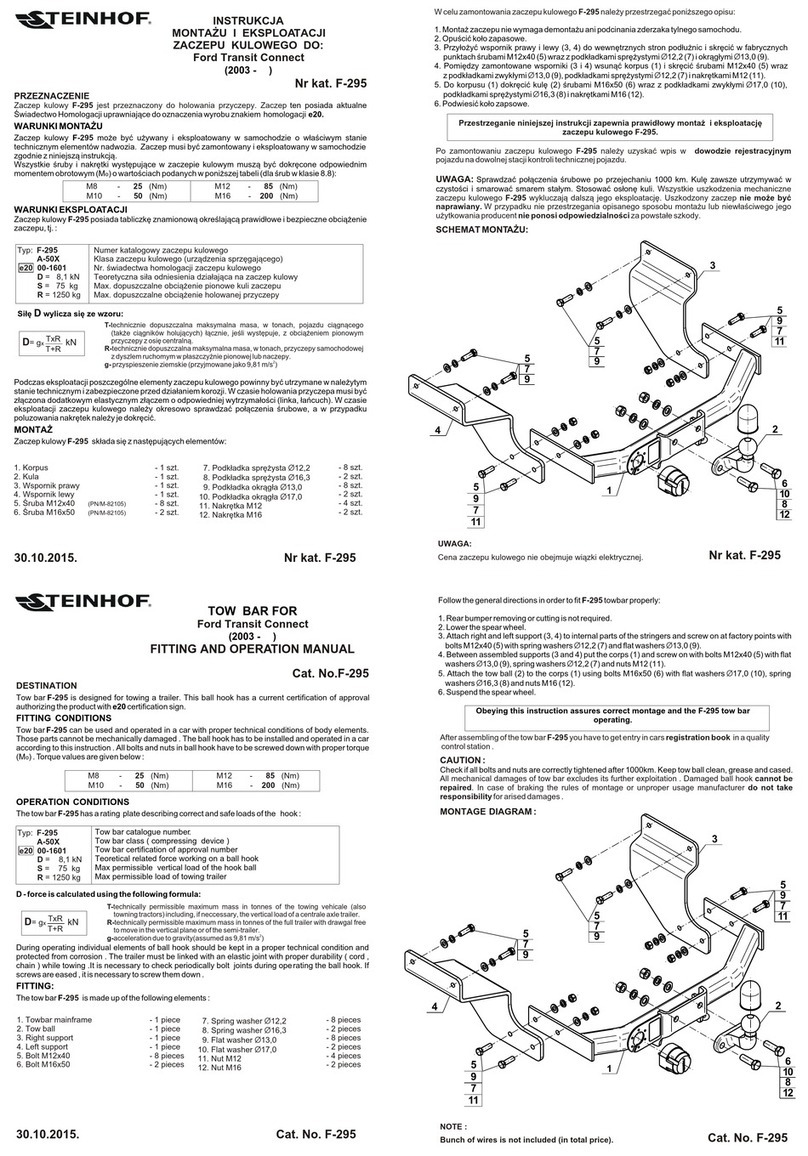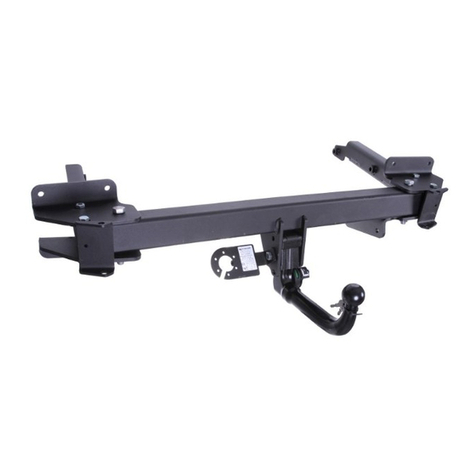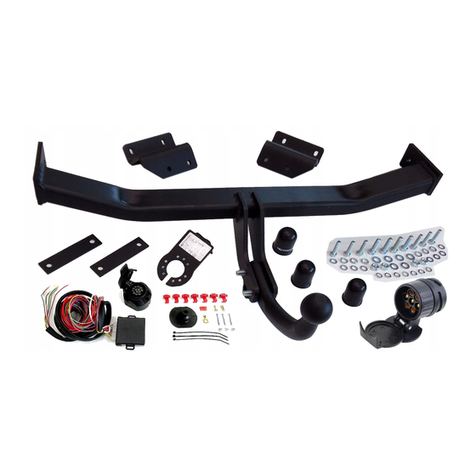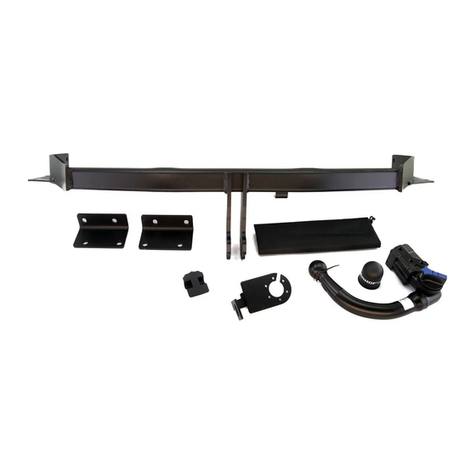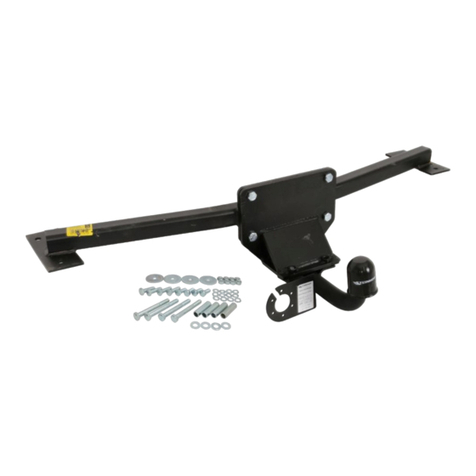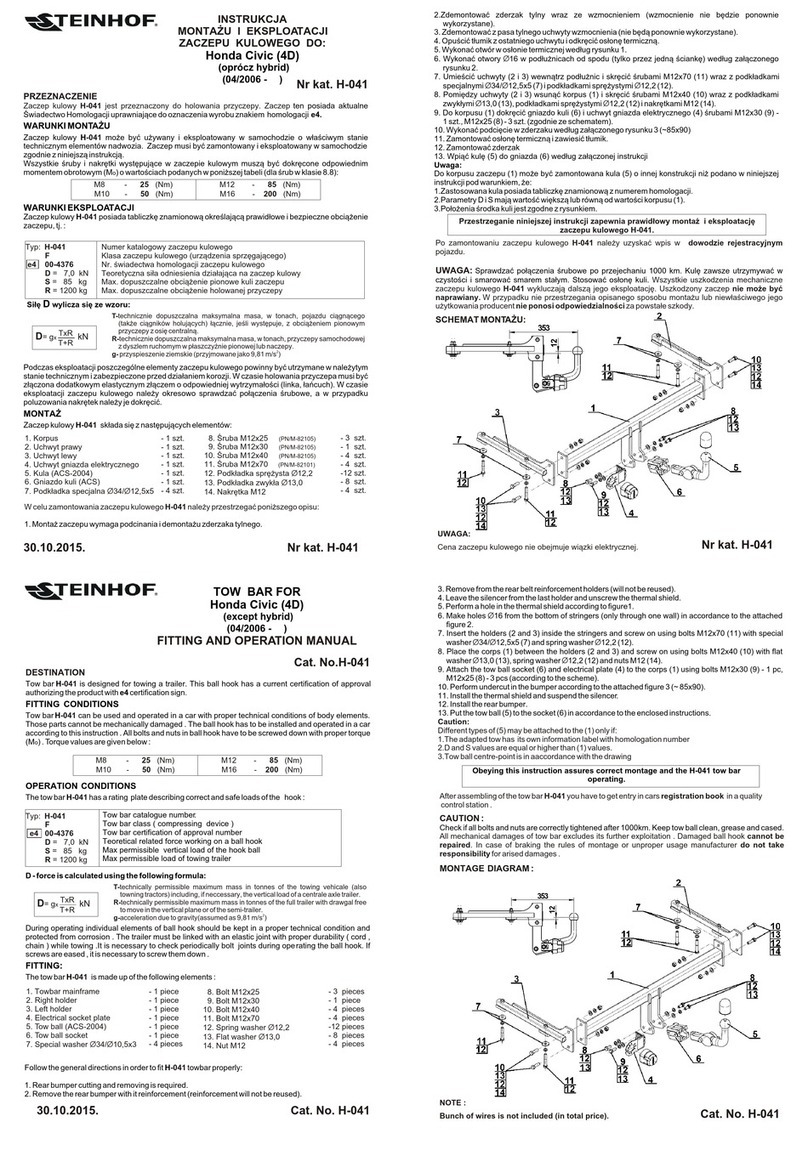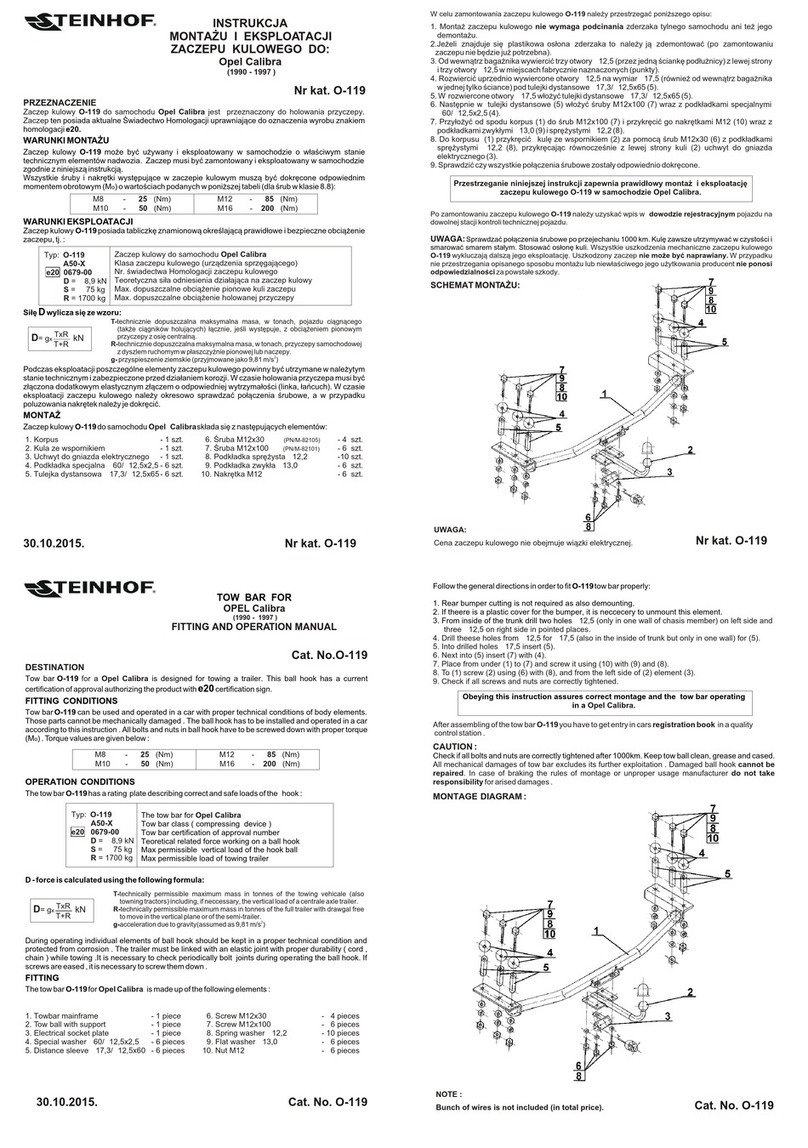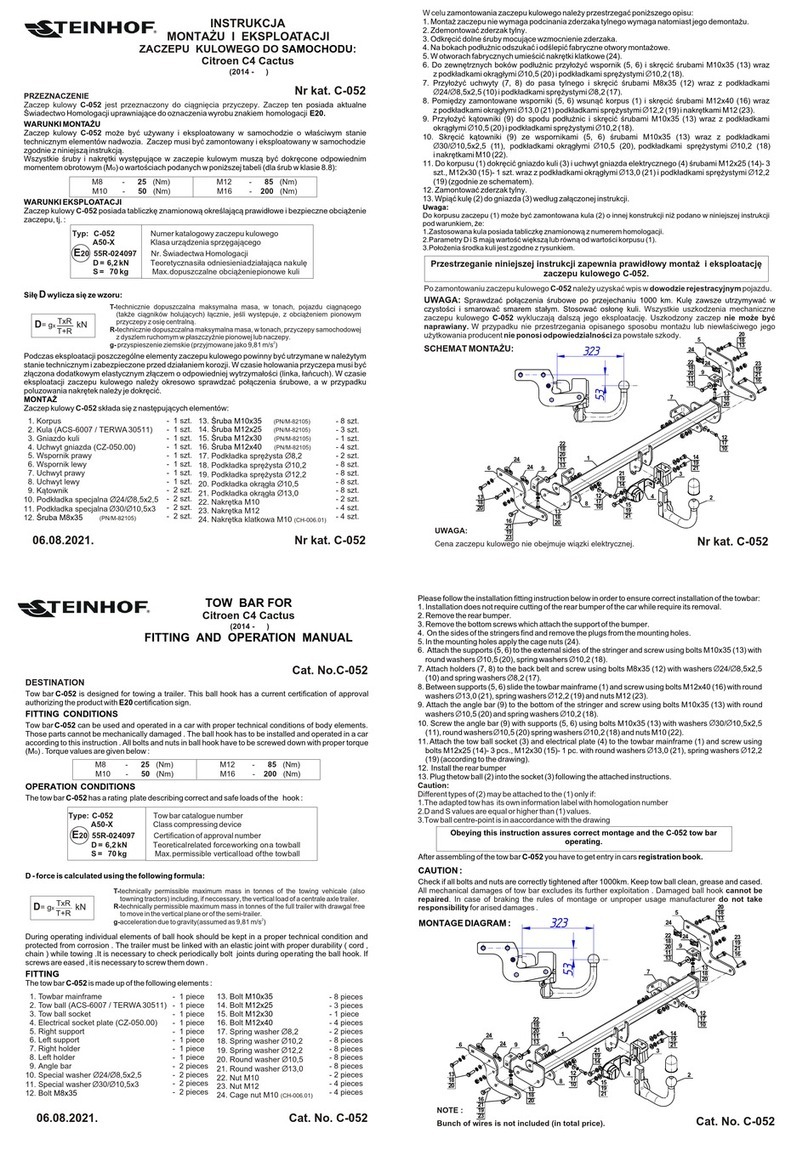
INSTRUKCJA
MONTA¯U I EKSPLOATACJI
ZACZEPU KULOWEGO DO:
Daewoo Nubira II Kombi
(02/1998 - )®
Nr kat. D-174
PRZEZNACZENIE
Zaczep kulowy D-174 do samochodu Daewoo Nubira II Kombi jest przeznaczony do holowania
przyczepy. Zaczep
Daewoo Nubira II Kombi
ten posiada aktualne Œwiadectwo Homologacji uprawniaj¹ce do oznaczenia
wyrobu znakiem homologacji e20.
WARUNKI MONTA¯U
Zaczep kulowy D-174 mo¿e byæ u¿ywany i eksploatowany w samochodzie o w³aœciwym stanie
technicznym elementów nadwozia. Zaczep musi byæ zamontowany i eksploatowany w samochodzie
zgodnie z niniejsz¹ instrukcj¹.
Wszystkie œruby i nakrêtki wystêpuj¹ce w zaczepie kulowym musz¹ byæ dokrêcone odpowiednim
momentem obrotowym (Mo) o wartoœciach podanych w poni¿szej tabeli (dla œrub w klasie 8.8):
WARUNKI EKSPLOATACJI
Zaczep kulowy D-174 posiada tabliczkê znamionow¹ okreœlaj¹c¹ prawid³owe i bezpieczne obci¹¿enie
zaczepu, tj. :
Si³ê Dwylicza siê ze wzoru:
Podczas eksploatacji poszczególne elementy zaczepu kulowego powinny byæ utrzymane w nale¿ytym
stanie technicznym i zabezpieczone przed dzia³aniem korozji. W czasie holowania przyczepa musi byæ
z³¹czona dodatkowym elastycznym z³¹czem o odpowiedniej wytrzyma³oœci (linka, ³añcuch). W czasie
eksploatacji zaczepu kulowego nale¿y okresowo sprawdzaæ po³¹czenia œrubowe, a w przypadku
poluzowania nakrêtek nale¿y je dokrêciæ.
MONTA¯
Zaczep kulowy D-174 do samochodu sk³ada siê z nastêpuj¹cych
elementów:
30.10.2015. Nr kat. D-174
M8 - 25 (Nm)
M10 - 50 (Nm)
M12 - 85 (Nm)
M16 - 200 (Nm)
Typ: D-174
A50-X
e20 0544-00
D = 7,2 kN
S = 70 kg
R = 1200 kg
Zaczep kulowy do samochodu Daewoo Nubira II Kombi
Klasa zaczepu kulowego (urz¹dzenia sprzêgaj¹cego)
Nr. œwiadectwa Homologacji zaczepu kulowego
Teoretyczna si³a odniesienia dzia³aj¹ca na zaczep kulowy
Max. dopuszczalne obci¹¿enie pionowe kuli zaczepu
Max. dopuszczalne obci¹¿enie holowanej przyczepy
Nr kat. D-174
UWAGA:
Cena zaczepu kulowego nie obejmuje wi¹zki elektrycznej.
W celu zamontowania zaczepu kulowego D-174 nale¿y przestrzegaæ poni¿szego opisu:
1.
Ø18 - wywierciæ po jednym otworze Ø12,5 od
spodu pod³u¿nic na przelot do wewn¹trz baga¿nika. Do wiercenia tego otworu zaleca siê na³o¿yæ na
wiert³o Ø12,5 tulejkê Ø17,3x80 (6).
Ø17,3x80 (6) nastêpnie przy³o¿yæ k¹townik prawy
(5) tak aby otwór Ø16 w tym k¹towniku wy³o¿y³ siê na trzpieniu bazowym pod³u¿nicy , a od góry tj. od
wewn¹trz baga¿nika w³o¿yæ w wywiercony otwór Ø12,5 œrubê M12x120 (10) wraz z podk³adk¹ specjaln¹
Ø40/Ø12,5x2,5 (7) i skrêciæ od spodu nakrêtk¹ M12 (15) wraz z podk³adk¹ sprê¿yst¹ Ø12,2 (13). To samo
wykonaæ na pod³u¿nicy lewej.
Ø12,5 od spodu
pod³u¿nic na przelot do baga¿nika.
Ø12,5 na wymiar Ø17,0 - ale tylko przez jedn¹ œciankê od strony baga¿nika.
7.W rozwiercone otwory w³o¿yæ od wewn¹trz baga¿nika tulejki dystansowe Ø17,3x80 (6) oraz poprzez
tulejki, œruby M12x120 (10) wraz z podk³adkami specjalnymi Ø40 (7) i skrêciæ razem od spodu pod³u¿nic
nakrêtkami M12 (15) wraz z podk³adkami sprê¿ystymi Ø12,2 (13).
8.Przy³o¿yæ korpus (1) do uprzednio wstêpnie przykrêconych k¹towników (4) , (5) i skrêciæ go razem œrubami
M12x30 (9) oraz nakrêtkami M12 (15) wraz z podk³adkami sprê¿ystymi Ø12,2 (13).
9.Od wewn¹trz baga¿nika w miejsca fabrycznych œrub M10x(1,25)x90 nale¿y wprowadziæ œruby
M10x(1,25)x100 (11) wraz z podk³adk¹ zwyk³¹ Ø10,5 (14) a od spodu na wystaj¹cy trzpieñ bazowy
nak³adamy podk³adkê specjaln¹ Ø38/Ø16,5x6,0 (8) wraz z podk³adk¹ zwyk³¹ Ø10,5 (14), sprê¿yst¹ Ø10,2
(12) i skrêciæ nakrêtk¹ M10x(1,25) (16).
10.Do korpusu (1) przykrêci kulê (2) ze wspornikiem œrubami M12x30 (9) wraz z podk³adkami sprê¿ystymi
Ø12,2 (13) przykrêcaj¹c równoczeœnie z lewej strony kuli (2) uchwyt do gniazda elektrycznego (3).
11.Sprawdziæ czy wszystkie po³¹czenia œrubowe zosta³y odpowiednio mocno dokrêcone.
Po zamontowaniu zaczepu kulowego D-174 nale¿y uzyskaæ wpis w dowodzie rejestracyjnym pojazdu na
dowolnej stacji kontroli technicznej pojazdu.
UWAGA:
.
SCHEMAT MONTA¯U:
Monta¿ zaczepu kulowego nie wymaga podcinania zderzaka tylnego samochodu. Nie wymaga równie¿
demonta¿u zderzaka tylnego.
2.Rozkrêciæ zaczep kulowy na elementy monta¿owe.
3.W pod³u¿nicy prawej i lewej - poprzez istniej¹ce otwory ~
4.Od spodu pod³u¿nicy prawej w³o¿yæ tulejkê dystansow¹
5.Poprzez otwory w k¹townikach - prawym (5) i lewym (4) wywierciæ po jednym otworze
6.Nastêpnie rozwierciæ otwory
Sprawdzaæ po³¹czenia œrubowe po przejechaniu 1000 km. Kulê zawsze utrzymywaæ w czystoœci i
smarowaæ smarem sta³ym. Stosowaæ os³onê kuli. Wszystkie uszkodzenia mechaniczne zaczepu kulowego
D-174 wykluczaj¹ dalsz¹ jego eksploatacjê. Uszkodzony zaczep nie mo¿e byæ naprawiany. W przypadku
nie przestrzegania opisanego sposobu monta¿u lub niew³aœciwego jego u¿ytkowania producent nie ponosi
odpowiedzialnoœci za powsta³e szkody.
Przestrzeganie niniejszej instrukcji zapewnia prawid³owy monta¿ i eksploatacjê
zaczepu kulowego D-174 w samochodzie Daewoo Nubira II Kombi.
D= gx kN
TxR
T+R
T-technicznie dopuszczalna maksymalna masa, w tonach, pojazdu ci¹gn¹cego
(tak¿e ci¹gników holuj¹cych) ³¹cznie, jeœli wystêpuje, z obci¹¿eniem pionowym
przyczepy z osiê centraln¹.
R-technicznie dopuszczalna maksymalna masa, w tonach, przyczepy samochodowej
z dyszlem ruchomym w p³aszczyŸnie pionowej lub naczepy.
2
g- przyspieszenie ziemskie (przyjmowane jako 9,81 m/s )
1. Korpus
2. Kula ze wspornikiem
3. Uchwyt do gniazda elektrycznego
4. K¹townik lewy
5. K¹townik prawy
6. Tulejka dystansowa
Ø17,3/Ø12,5x80
7. Podk³adka specjalna
Ø40/Ø12,5x2,5
- 1 szt.
- 1 szt.
- 1 szt.
- 1 szt.
- 1 szt.
- 4 szt.
- 4 szt.
- 2 szt.
-10szt.
- 4 szt.
- 2 szt.
- 2 szt.
-14szt.
- 4 szt.
-10szt.
- 2 szt.
8. Podk³adka specjalna
Ø38/Ø16,5x6,0
9. Œruba M12x30
10.Œruba M12x120
11.Œruba M10x(1,25)x100
12.Podk³adka sprê¿ysta Ø10,2
13.Podk³adka sprê¿ysta Ø12,2
14.Podk³adka zwyk³a Ø10,5
15.Nakrêtka M12
16.Nakretka M10x(1,25)
TOW BAR D-174 FOR
®
Daewoo Nubira II Kombi
(02/1998 - )
FITTING AND OPERATION MANUAL
DESTINATION
for Daewoo Nubira II Kombi
Daewoo Nubira II Kombi
Tow bar D-174 a is designed for towing a trailer. This ball hook has a
current certification of approval authorizing the product with e20certification sign.
FITTING CONDITIONS
Tow bar D-174 can be used and operated in a car with proper technical conditions of body elements.
Those parts cannot be mechanically damaged . The ball hook has to be installed and operated in a car
according to this instruction . All bolts and nuts in ball hook have to be screwed down with proper torque
(Mo) . Torque values are given below :
OPERATION CONDITIONS
The tow bar D-174 has a rating plate describing correct and safe loads of the hook :
D - force is calculated using the following formula:
During operating individual elements of ball hook should be kept in a proper technical condition and
protected from corrosion . The trailer must be linked with an elastic joint with proper durability ( cord ,
chain ) while towing .It is necessary to check periodically bolt joints during operating the ball hook. If
screws are eased , it is necessary to screw them down .
FITTING
The tow bar D-174 for is made up of the following elements :
Cat. No.D-174
30.10.2015. Cat. No. D-174 Cat. No. D-174
M8 - 25 (Nm)
M10 - 50 (Nm)
M12 - 85 (Nm)
M16 - 200 (Nm)
Typ: D-174
A50-X
e20 0544-00
D = 7,2 kN
S = 70 kg
R = 1200 kg
The tow bar for
Tow bar class ( compressing device )
Tow bar certification of approval number
Teoretical related force working on a ball hook
Max permissible vertical load of the hook ball
Max permissible load of towing trailer
Daewoo Nubira II Kombi
NOTE :
Bunch of wires is not included (in total price).
D= gx kN
TxR
T+R
T-technically permissible maximum mass in tonnes of the towing vehicale (also
towning tractors) including, if neccessary, the vertical load of a centrale axle trailer.
R-technically permissible maximum mass in tonnes of the full trailer with drawgal free
to move in the vertical plane or of the semi-trailer.
2
g-acceleration due to gravity(assumed as 9,81 m/s )
Follow the general directions in order to fit D-174 tow bar properly:
1.
Check if all bolts and nuts are correctly tightened after 1000km. Keep tow ball clean, grease and cased.
Rear bumper cutting is not required.
2. Unpack the towbar packing and separate components. Check all parts are present.
3. Drill 1 hole 12,5 through existing holes - 18-into the right and left chassis side member, from the
bottom of the chassis side members.
4. Insert (6) into the bottom of the chassis side member, next put (5) , insert from the top (10), (7) into
previously drilled hole 12,5 and attach using (15) with (13). Make the same with left chassis side
member.
5. Drill for 1 hole 12,5 through the holes in (5) and (4), from the bottom of the chassis side member.
6. Drill the holes from 12,5 to 17,0- through the one wall from the bottom side.
7. Insert (6) from the bottom of the trunk and (10) , (7) through the distance sleeve, next attach from the
bottom of the trunk using (15) with (13).
8. Put (1) to the previously attached (4), (5) and attach using (9), (15), (13).
9. Insert (11), (14) and put from the bottom (8), (14), (12) and attach using (16).
10.Attach (2) to (1) using (9), (13) attach (3) on the left side of (2).
11.Check if all bolts and nuts are correctly tightened.
After assembling of the tow bar D-174 you have to get entry in cars registration book in a quality
control station .
CAUTION :
All mechanical damages of tow bar excludes its further exploitation . Damaged ball hook cannot be
repaired. In case of braking the rules of montage or unproper usage manufacturer do not take
responsibility for arised damages .
MONTAGE DIAGRAM :
ØØ
Ø
Ø
ØØ
Obeying this instruction assures correct montage and the tow bar operating
in a Daewoo Nubira II Kombi.
1. Towbar mainframe
2. Tow ball with support
3. Electrical plate
4. Left angle bar
5. Right angle bar
6. Distance sleeve Ø17,3/Ø12,5x80
7. Special washer Ø40/Ø12,5x2,5
8. Special washer Ø38/Ø16,5x6
- 1 piece
- 1 piece
- 1 piece
- 1 piece
- 1 piece
- 4 pieces
- 4 pieces
- 2 pieces
9. Bolt M12x30
10.Bolt M12x120
11.Bolt M10x(1,25)x100
12.Spring washer Ø10,2
13.Spring washer Ø12,2
14.Flat washer Ø10,5
15.Nut M12
16.Nut M10(1,25)
-10pieces
- 4 pieces
- 2 pieces
- 2 pieces
-14pieces
- 4 pieces
-10pieces
- 2 pieces


